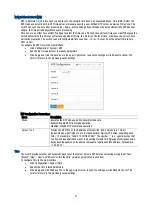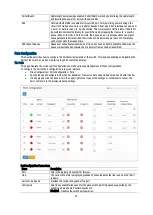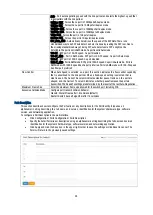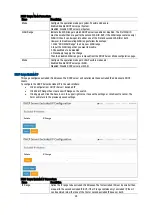
14
To install a SFP transceiver:
Consider network and cabling requirements to select an appropriate SFP transceiver type.
Insert the transceiver with the optical connector facing outward and the slot connector facing down. NOTE: that
SFP transceivers are keyed so they can only be installed in one orientation.
Slide the SFP transceiver into the slot until it clicks into place.
Making Network Connections
The switch is designed to be connected to 10, 100 or 1000Mbps network cards in PCs and servers, as well as to other
switches and hubs. Each device requires an unshielded twisted-pair (UTP) cable with RJ45 connectors at both ends. Use
Cat 5e or 6 cables for 1000BASE-T connections, Cat 5 or better for 100BASE-TX connections.
•
Attach one end of a twisted-pair cable segment to the device’s RJ45 connector.
•
If the device is a network card and the switch is in the wiring closet, attach the other end of the cable segment to
a modular wall outlet that is connected to the wiring closet. (See the section “Network Wiring Connections.”)
Otherwise, attach the other end to an available port on the switch.
NOTE: Avoid using flow control on a port connected to a hub unless it is actually required to solve a problem.
Otherwise back pressure jamming signals may degrade overall performance for the segment attached to the hub.
•
As each connection is made, the Link LED (on the switch) corresponding to each port will light green (1000 Mbps)
or amber (100Mbps) to indicate that the connection is valid.
The punch-down block is an integral part of many of the newer equipment racks. It is actually part of the patch panel.
Instructions for making connections in the wiring closet with this type of equipment follows.
•
Attach one end of a patch cable to an available port on the switch, and the other end to the patch panel.
•
If not already in place, attach one end of a cable segment to the back of the patch panel where the punch-down
block is located, and the other end to a modular wall outlet.
•
Label the cables to simplify future troubleshooting. See “Cable Labeling and Connection Records”.
Switch
Equipment Rack
(side view)
Patch Panel
Patch-Down Block
Wall
When adding hubs to your network, please note that because switches break up the path for connected devices into
separate collision domains, you should not include the switch or connected cabling in your calculations for cascade
length involving other devices.
1000BASE-T Cable Requirements
All Category 5 UTP cables that are used for 100BASE-TX connections should also work for 1000BASE-T, providing that all
four wire pairs are connected. However, it is recommended that for all critical connections, or any new cable installations,
Category 5e or Category 6 cable should be used. The Category 5e and 6 specifications include test parameters that are
only recommendations for Category 5. Therefore, the first step in preparing existing Category 5 cabling for running
1000BASE-T is a simple test of the cable installation to be sure that it complies with the IEEE 802.3-2005 standards.






























